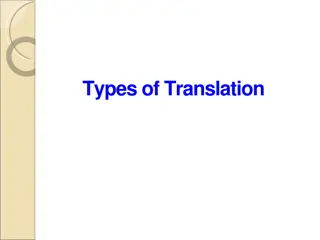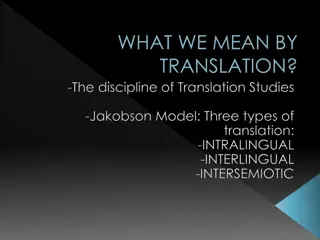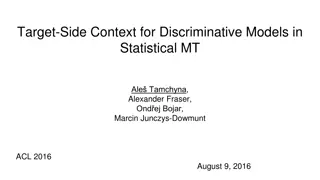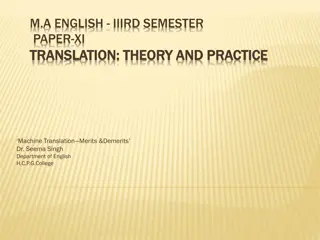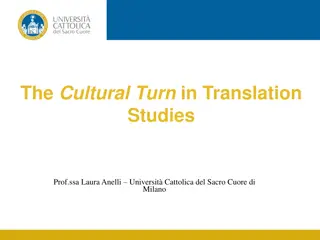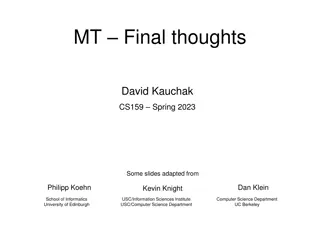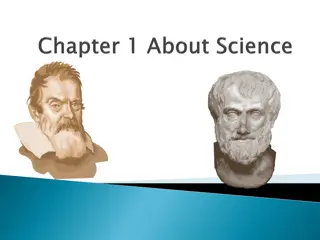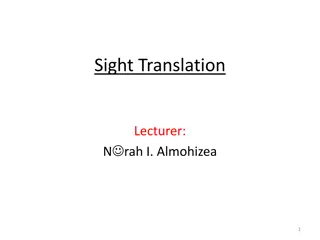Understanding Scientific Translation: A Vital Tool for Advancing Knowledge
Scientific translation is a specialized practice that involves accurately translating complex terms in fields such as science and technology to facilitate global knowledge exchange and advancement. It requires precision, fidelity to source material, and a deep understanding of technical terminology across various disciplines. Overcoming challenges, such as translating scientific terms from English to Arabic, is crucial for enriching languages and promoting global scientific cooperation.
Download Presentation

Please find below an Image/Link to download the presentation.
The content on the website is provided AS IS for your information and personal use only. It may not be sold, licensed, or shared on other websites without obtaining consent from the author. Download presentation by click this link. If you encounter any issues during the download, it is possible that the publisher has removed the file from their server.
E N D
Presentation Transcript
TECHNICAL & SCIENTIFIC TRANSLATION
General Introduction Scientific translation is not like other translations, it goes beyond just rendering words from one language into another. It is rather considered a tool that helps people around the world develop and progress in the field of science. Thus a translator needs to ensure an accurate delivery of information and shows faithfulness and commitment to the source and the target language, so that the translated information can be used easily and help in developing other countries.
One of the main problems that translation trainees may face is how to deal with translating scientific terms from English into Arabic, and in choosing the best method to achieve a high- quality translation of those terms which may enrich theArabic language.
Scientific Register Definition of Science Many definitions have been given to the word science. CambridgeAdvanced Learner sDictionary defines science as: 1. (Knowledge obtained from), the systematic study of the structure and behavior of the physical world, especially by observing, measuring and experimenting, and the development of the theories to describe the results of these activities. 2.Aparticular subject that is studied using scientific methods.
Generally speaking, science is a word that refers to the organized approach of attaining knowledge, using a scientific method that helps to organize thought, procedures and then come into clear, faithful and reliable results, free of subjectivity and personal involvements.
Definition of Scientific Translation Scientific translation is mainly about translating terms in the fields of science and technology of all kinds, medicine, physics, chemistry, mathematics, computer sciences...etc from one language into another (Ghazzala 1995). Scientific translations do not involve literary texts; they only deal with texts from the world of electronics, medicine, law, economics, engineering, chemistry, computer science, automotive engineering, geology, etc. The number of technical fields is infinitely large, and terminology is expanding and changing daily.
The scientific translation is considered as one of the most important issues, as the world develops, new technology appears, and along with them emerge new terms to which finding an equivalent may pose a problem. As Nida (1964) said in this point; it is not easy at all to translate scientific terms that emerged in western developed countries languages into a language of third world countries which are still having financial and social problems.
Definitions of Technical Translation Defined by Wright & Wright (1993), [t]echnical translation encompasses the translation of special language texts, i.e., texts written using Languages for Special Purposes (LSP). As such, technical translation (and technical terminology as well) includes not only the translation of texts in engineering or medicine, but also such disciplines as economics, psychology and law (p. 1).
In the broader sense, technical translation is synonymous to specialized translation. In the narrower sense, technical translation is one part of specialized translation (Newmark, 1988, p. 151).
Despite the obvious connection between technical and scientific translation, Newmark (1988) notes, in science, the language is concept-centered; in technology, it is object- centered (p. 155). Likewise, Byrne (2006) argues that, scientific translation relates to pure science in all of its theoretical, esoteric and cerebral glory while technical translation relates to how scientific knowledge is actually put to practical use (p. 8).
It is true that scientific and technical translations differ in terms of subject matter, language and purpose, as Newmark and Byrne maintain, yet, it seems that both types are very much alike in terms of the techniques of translation involved. That is perhaps why Olohan(2015) uses the expression scientific and technical, not as a reference to the same type of translation, but as an indication that they share some features, challenges or approaches (p. 7) and that any discussion of technical translation can equally hold for scientific translation.
The Aim of Scientific Translation Byrne (2006) claims that, scientific translation primary goal is to deliver scientific information; it aims at presenting well expressed information, that may be used easily, properly and effectively. He referred to scientific translation as a communicative service, which offers new information for new audience, since scientific translation is regarded as communicative service; it certainly involves three main people, which are the author, the translator and the reader.
He added also, that it is much more than just rendering source text language and style. Its main concern is to ensure delivering information accurately and correctly, in that it insures that the reader may use this information easily.
Requirements of a Scientific Translator Scientific translators are not like other ordinary translators. There are certainqualifications that they should have in order to accomplish a good translation of scientific texts as well as to deliver the exact information. This is because scientific translation is not just to transfer ideas or information, but rather to transfer technology and new invention that may help other countries. According to the Thivierge (2002:188) The work of scientific translators is to achieve one primary goal: to write information in a clear, concise, and accurate manner . biomedical writer Bethany
He claimed that there are nine requirements that a scientific translator should observe: 1. Work appropriate for the intended audience. 2. Respect for choices made by the author. 3. Respect for references. 4. Understanding of sciences. 5. Understanding of languages. 6. Constructive questions. 7. Work suitable for publication. 8. Familiarity with current practices. 9. Timely exchange of work.
Following the same sense, Al-Hasnawi (2010) also discriminated six characteristics taken from the London Institute of Linguistics- that the scientific translator should have: 1. Broad knowledge of the subject-matter of the text to be translated; 2. A well-developed imagination that enables the translator to visualize the equipment or process being described; 3. Intelligence, to be able to fill in the missing links in the original text; 4. A sense of discrimination, to be able to choose the most suitable equivalent term from the literature of the field or from dictionaries; 5. The ability to use one's own language with clarity, conciseness and precision; 6. Practical experience in translating from related fields.
Byrne communicating via the translated texts, in that he should look further than the source text only to get more information from different sources, to ensure an effective target text which serves the communicative purpose. Consequently, the translator becomes according to G pferich (1993) and Amman & Vermeer (1990:27) the intercultural or cross-cultural scientific writer . Byrne (2006:17) goes further and claimed (ibid) also claimed that scientific translator is The need for translators to conduct research so as to understand not just the text but also the subject while at the same time ensuring, by means of revisions and corrections, that the text conforms to target language norms and target audience expectations.
Out of the six requirements listed above, the first deserves special consideration because it bears on the early attempts to found a theory of translation advocating that the text whether literary or scientific should be dealt with according to the way language is used in them (Adams, 1967: 87).
Scientific versus Literary Contexts By setting off scientific against the literary translation, their characteristics and the problems that are likely to be encountered in each, become more salient as illustrated below.
Scientific Texts - Logicality. Literary Texts - Lack of argumentative progression. - Precision. - Reason. - Vagueness. - Emotion. - Truth to the ideal. - Concretion. - Emotive meaning. - Connotation. - Grammatical affixation. - Idiomatic expressions are frequent. - Truth to particular reality. - Generalization. - Referential meaning. - Denotation. - Lexical affixation. - Idiomatic expressions are rare. - Use of abbreviation, acronym, and registers. - Standard expressions. - Use of scientific terminology, specialized items, and formulae. - Very few abbreviations, acronyms, and registers. - Almost all varieties. - No use of scientific terminology, or formulae. - No use of elements of figurative language. - Expensive use of figurative language.
Scientific Register Generally speaking, the technical use of language manifests itself in several ways. The most obvious one is non-deviation from logically and argumentative progression. may entail the adherence conventionally used. ordinary grammar, This are to items that For the purpose of more vivid characterization of these texts, we shall mention some major ones of these features by referring to Bakr-Serex (1997: 54-7):
First, this register is characterized by the logical order of utterances with clear indication of their interrelations and interdependence. Second, it flourishes the use of terms specific to each given branch of science; in modern science; however, there is a tendency to exchange terms between various branches of science. Third, another characteristic feature of this register is the frequent use of specific sentence-patterns, usually the Postulatory- A thing that is accepted as true or as certain to happen, without proof , the Argumentative and the Formulative express an idea in a concise or systematic way patterns. The impersonality of this type of writing can be revealed in the frequent use of passive voice constructions with which scientific experiments are generally described.
Fourth, one more observable feature of the scientific register is the use quotations, references, and foot-notes in accord with the main requirement of this register, i.e. the logical coherence of the ideas expressed. Finally, science does not have its own syntax only, but also its own terminology. And we have already hinted at the importance of the familiarity with this terminology resting on a solid foundation of previously acquired knowledge on behalf of the translator. Therefore, it is not the language itself which is special, but certain words or their symbols.
Definition of terminology Webster s new world college dictionary defines Terminology as follows: 1. the terms or system of terms used in a specific science, art, etc.; nomenclature lexicographer's terminology 2. the systematic study of terms
On the other hand, Cambridge Advanced Learners Dictionary defines terminology as: Special words or expressions used in relation to a particular subject or activity . Terminology is viewed as a structured set of concepts and their labels in a particular subject field, it can be considered the infrastructure of specialized knowledge. Technical writing and scientific papers are thus impossible without properly using terminological resources. Terminology refers to all specific terms and expressions used in a specific register as the terms: endocrine system, cells, and hormones which are specific terms generally used in scientific texts.
Scientific Terminology Scientific terms are not simple words; they are special and complex ones. Scientific terms are the most significant feature in science, they discriminate it from other registers (literary). These terms make scientific texts incomprehensible for lay people; they are directed to experts of the science. Thus scientists use them to dignify their written works, in that William Zinasser (1976) explained that each jargon has its own list of terms which lay people would not understand easily. He (1976:15) wrote Every profession has its growing arsenal of jargon to fire at the lay man and hurls him back from its walls. Furthermore, Ilyas (1989:109) claimed that scientific terminology varies from the regular and literary words since they associations and implications . do not accumulate emotional
Terminology is the study of terms which refer deliberately to specific concepts within particular subject fields. In other words, terms are always studied in relation to the conceptual system to which they belong and in which they function as depositors of knowledge [3]. Neologisms can be defined as newly coined lexical units or existing lexical units that acquire a new sense [4], and although they cause a lot of trouble to translators, they are at the same time popular with both writers and readers. Moreover, finding equivalents in Arabic for technical English terms causes many problems owing to the different nature of both languages.
These problems are likely to be manifested in the continuous development in the field of science and technology as well as the effect of mass media on people who almost, everyday, receive new ideas and innovations. Some of these problems can be identified as follows:
First, English utilizes Latin or Greek compound morphemes to express some of these technical terms, e.g. television which is a term made up of two free morphemes telos, meaning remote and vision meaning sight or image. This compound term is used for a set that brings images from a distance, thus, denoting its function. English also encompasses terms which are built of Greek or Latin roots or combination of the two such as automobile, telephone. Experience has shown that apart from changes in orthography, scientific terms taken from Greek or Latin are admissible by the entire scientific world regardless of language. Arabic, in contrast, is not as flexible as English in either borrowing from other languages or in using compound morphemes. This could be attributable to its rigorous grammatical rules which were formulated in the medieval period.
Second, many of these technical terms are the products of the West, i.e. they stand for products invented in Europe or America which made it easier for the inventors to name them either after their own names, or resorting to European languages instead of Latin or Greek. For instance, Watt stands for the electric current unit which is named after the person who invented this unit of measurement and the term pasteurization which refers to a method of sterilizing, especially milk, devised by the French scientist Louis Pasteur.
Third, there is no agreement among the Arabs on the rendering of scientific and technical terms. For instance, the English term engine which is of a Latin origin has no agreed- upon Arabic term; in some parts of the Arab world it is transliterated as and in other parts where people are reluctant to use foreign names they instead prefer to give it the Arabicized name . However, the problem is that this term literally means a mover, a term that can be used vaguely for even a person moving something. Another example of this problem is the term mobile which has about eight Arabic equivalents: silil r, mub yl, burt ble, maHm l, jaww l, h tif mutaHarik, khilyaw and naqq l the matter that give rise to the abundance of terms.
Fourth, most of the foreign terms are strange and new to the Arab environment and culture making it difficult if not possible to find equivalents for every term in Arabic. For example, the term satellite causes a lot of trouble for translators; some translators opted for keeping its original Latin name satalayit others translated it semantically as has been given an Arabic term by the Arabic Academy in Tangeer. and recently, it
Strategies of Translating English Technical Terms into Arabic Dealing with terminology requires specific skills in the form of some strategies that are likely to be fruitful and serve the target language. In this respect, numerous options are available for translators to translate scientific terms into Arabic. On the other hand, several Arabic agencies have devoted themselves officially or unofficially to produce new set of terminology for Arabic that translation process when it comes to introduce new terms from the source language. may facilitate the
There scientific terms into Arabic; each method differs from the other in the use and the results it produces. Those techniques will be discussed and ordered from the poorest to the best . are several methods of translating
Transcription/Arabicization Transcription or Arabicization is one of the strategies widely used to translate scientific terms by introducing minor phonetic and morphological changes to the foreign term. It consists of writing the English scientific terms using the Arabic alphabet with no alteration to their pronunciation in the source language. Take the following examples: 1. Microwave , 2. Mega bite 3. Tetra bite
The problem with Arabicization/ Transcription is that it does not give the meaning of the word in Arabic, besides the transcribed terms are not pure Arabic ones; they are just borrowed and shaped in Arabic letters. Using transcription neither serves the Arabic language nor enriches its vocabulary. In fact, it is just an offence to the Arabic language, because it implies that Arab translators are unable to invent new pure Arabic terms and prefer the easy way to translate scientific terms, thus, neglecting the significant statue of theArabic language. Following this line of thought, Ghazzala (1995) argued that this method should be avoided except in the case where translators could not find equivalent for the term inArabic language. For example: 1. Sandwich
Yet, if the terms have equivalent in Arabic, translators have to use them instead of transcription, for example: 1. Computer 2. Virus This method will be considered as a critical problem opposed to translators, if they use it for ordinary terms that have equivalents in Arabic as shown by the word email usually transcribed as and for which the phrase can be used.
According to Baker (1987) transcription and naturalization have not received acceptance from the language purists because they threaten the identity of Arabic. Thus, translators are likely to come across a situation where they need to be more creative by following certain methods that may ensure the high quality and smoothness of translating scientific terms. In an attempt to get over this obstacle, Ghazzala (1995) suggested that coinage is the best method for translating scientific terms. As for Baker (1987); coining new terms is the only way that ensures the creation of new specialized glossaries for theArabic language.
Coinage This method aims at presenting new terms in the Arabic language via three mainprocesses. 1. Derivation Baker (1987) said that the Arabic language is usually referred to as the language of derivation. She explained that the Arabic language word root system is built up on three fundamental consonant roots; each one holds a given meaning. The roots are used for the production of nominal and verbal forms by adding prefixes, suffixes, infixes and vowels. For example: 1. Data from to give 2. Generator from to generate. 3. Factory from to manufacture 4. Studio from . to paint
According to Ghazzala (1995) derivation is based on measurements; it aims at using certain measures found in the Arabic language to derive new terms. The most used ones are machine-names. For example: . 1 a. Laboratory b. Anchorage . 2 a. Grease box b. Butchery . 3 a. Refrigerator b. Mixer 4 a. Drill b. Iron
Baker (1987) supported this method and claimed that it makes understanding of the meaning of terms easier for the readers since they are inherited from the root, which is already familiar, used to derive that term. In other words, the derived terms are not new to the vocabulary, they already exist but in different forms. Furthermore, it is favored by academics since it does not affect the identity of the Arabic language and the derivation process is based on pureArabic vocabulary roots. On the other hand, Ghazzala (1995) argued that derivation is still a restricted waybecause it cannot be applied to all the terms as some of them would not accept measures.
2. Revival Revival attempts to put back into use old Arabic words that were used but fade away with the time and assigns them new meanings. Baker (1987) said that this method uses Arabic lexicon instead of trying to introduce new concepts that may take time to be adopted. For example: 1. Train originally used to mean a line of camels 2. Car originally used to mean the night travelers 3. Environment originally used to mean domicile 4. Newspaper originally used to mean the small palm stick was used to writeon
Revival has proved its efficiency, however, it is still not easy to look for old Arabic words; it consumes time and effort and cannot be applied to cover all new introduced terms in the field of science. Using this method is not always successful because some of the attempts to revive archaic words did not suit modern Arabic vocabulary; they were a subject of much ridicule (Baker, 1987:186).
Neologisms aim at introducing new terms and concepts into the Arabic language by translating the meaning. This method according to Baker (1987) enjoys much acceptance. For example: 1. Computer programming 2. Software 3. Hardware 4. Phonetics 5. word processing 6. Psychoanalysis
Finally, there have been great efforts to bring new technical terms into Arabic, by any means available, yet these methods should not threaten the Arabic identity. Translators should consider the linguistic differences between English and Arabic, for that they need to coin terms that linguistically conform with Arabic norms.
Circumlocution Circumlocution terms into Arabic by giving the meaning of the foreign term. It is a universal phenomenon in natural languages covering all aspects of vocabulary [13]. This approach is also called in Arabic . (literally: derivation of meaning). This method which was one of the methods of producing numerous terms since the first Abbasid period has been formally recognized by Arab academies. This recognition comes as a result of the abundance of foreign terminology especially compound neologisms where conventional attempts to reduce them to one-word terms have failed, is a method of introducing new
for instance the word ideal is translated as Sometimes an English word is translated into Arabic through a whole statement, for example the term burglar is rendered according to Oxford English-Arabic dictionary as (a thief breaks into houses during the night). Similarly the following examples are also approved by the academies: . Cartoon Video Microphone
Despite the fact that circumlocution is used to solve the problem of composite neologisms, it has also led to the problem of dualism of terminology in Arabic. This is because the translator or the neologizer is not bound by any rules while translating foreign terms. Many composite Arabic terms have variants or are not sufficiently current in their literary usage. For example: the phrase conditioned reflex is translated into Arabic sometimes sometimes as as [9] and
In summary, it has been observed from the discussion above that circumlocution, unlike other methods, seems to be less adequate and leads to the multiplicity of terms due to the following: It produces longer terms than the original. It is usually a phrase and not a word that presents syntactic problems. In addition, translation of these neologisms often deviates from their real functional meaning. Some translators invent their own arbitrary translation which does not go with the Arabic molds and rules.
Arab academies as well as some other prominent translators are influenced by different foreign cultures (English and French) which result in different translated terms. Therefore, the Arab academies should take into consideration the following factors in translating foreign terms: They should consider the social use of language because people usually prefer easily pronounceable terms to difficult ones. Compound terms with difficult structures should be avoided. Short terms are more preferable than long ones. Although there are Arabic equivalents to the English prepositions, on and off which are and many people are reluctant to use the Arabic versions and still prefer to use the English terms because they are shorter and easier to pronounce.





